Contents
- Physical Features
- Climate
- Geology
- Soil
- Minerals
- Rivers
- Botany
- Wild Animals
- Birds
- Fishes
- Forest Reserves
- Koka- Nagzira Wildlife Sanctuary
- Umred Karhandla Wildlife Sanctuary
- Land Use
- Environmental Concerns
- Water Pollution
- Air Pollution
- Illegal Mining
- Human-Wildlife Conflict
- Climate Change Vulnerability
- Conservation Efforts
- Malgujari Tanks
- Graphs
- Water
- A. Rainfall (Yearly)
- B. Rainfall (Monthly)
- C. No. of Rainy Days in the Year (Taluka-wise)
- D. Evapotranspiration Potential vs Actual Numbers (Yearly)
- E. Annual Runoff
- F. Runoff (Monthly)
- G. Water Deficit (Yearly)
- H. Water Deficit (Monthly)
- I. Soil Moisture (Yearly)
- J. Seasonal Groundwater Levels: Bore Wells
- K. Seasonal Groundwater Levels: Dug Wells
- Climate & Atmosphere
- A. Maximum Temperature (Yearly)
- B. Maximum Temperature (Monthly)
- C. Minimum Temperature (Yearly)
- D. Minimum Temperature (Monthly)
- E. Wind Speed (Yearly)
- F. Wind Speed (Monthly)
- G. Relative Humidity
- Forests & Ecology
- A. Forest Area
- B. Forest Area (Filter by Density)
- C. Wildlife Projects (Area and Expenses)
- Human Footprint
- A. Nighttime Lights
- Sources
BHANDARA
Environment
Last updated on 6 November 2025. Help us improve the information on this page by clicking on suggest edits or writing to us.
Bhandara district in Maharashtra, often referred to as the "Lake District of Maharashtra," is renowned for its rich natural environment, characterized by sprawling forests, fertile agricultural lands, and a network of rivers and lakes, including the historic Malgujari lakes.
Physical Features
The Bhandara district is located in the eastern part of Maharashtra and lies along the banks of the Wainganga River. It is situated at an altitude of 244 meters above mean sea level and spans an area of 3,717 square kilometers. The district is bordered to the north by the Balaghat district of Madhya Pradesh, to the south by Chandrapur, and has a small border with Gadchiroli in the southeast. Gondia and Nagpur mark their eastern and western borders, respectively. Bhandara district comprises seven tahsils: Tumsar, Mohadi, Bhandara, Pavani, Sakoli, Lakhani, and Lakhandur.
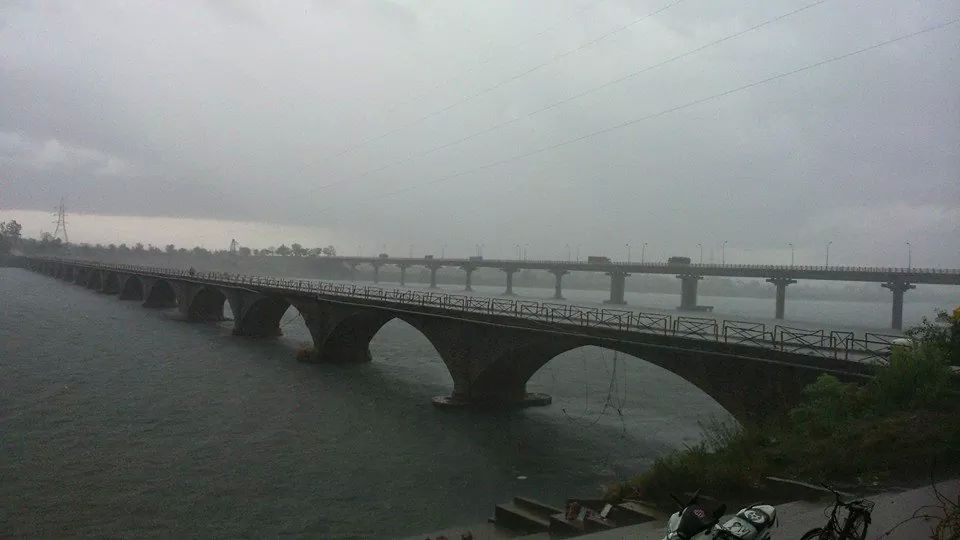
Other rivers include Kanhan, Sur, Bawanthadi, and Chulbandh, with Bhavanthali and Chulbandh being the prominent dams. The Ambagarh range, an outlier of the Satpura range, covers the western part of the district and trends in a north-easterly direction, separating the valley of the Bawanthadi River from the rest of the district. The ruins of Ambagarh Fort in Tumsar taluka are situated 300 m above mean sea level and were built in the 1700s by Rana Khan Pathan, the subedar of Bakht Buland Shah.
In the center of the district runs the Gaikhuri range, a cluster of low peaks surrounded by irregular forests. The highest peaks in this range are Khura (610 m), Lendejhari (454.15 m), and Jamri (521.81 m). This range divides the valleys of the Wainganga and Bagh rivers. The Sakoli tahsil, located in the southern portion of the district, consists largely of hills and forests. In contrast, other areas feature vast expanses of rice and wheat fields alongside fruit-bearing trees.
Climate

The district of Bhandara is generally characterized by dry weather for most of the year, with average temperatures varying between 23°C and 34°C. The climate features a hot summer and well-distributed rainfall during the southwest monsoon season. The cold season lasts from December to February, with January being considered the coldest month, averaging around 15°C. Summers extend from March to about mid-June, with May recognized as the hottest month, averaging around 44°C.
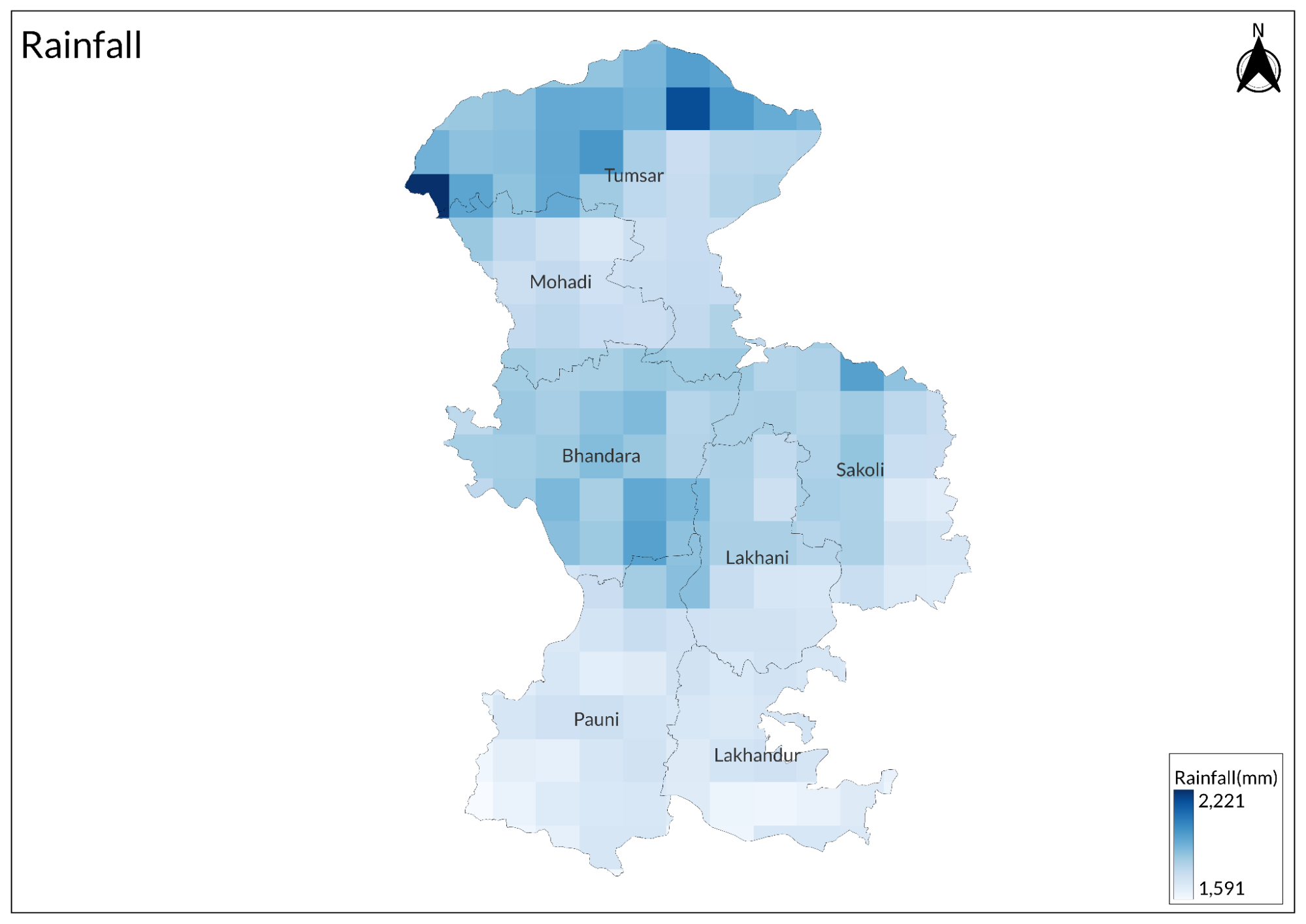
The monsoon period spans from mid-June to early October, with July noted as the wettest month, receiving an average rainfall of 571 mm. October and November constitute the post-monsoon season, with November being the driest month, averaging only 8.0 mm of rainfall.
Geology
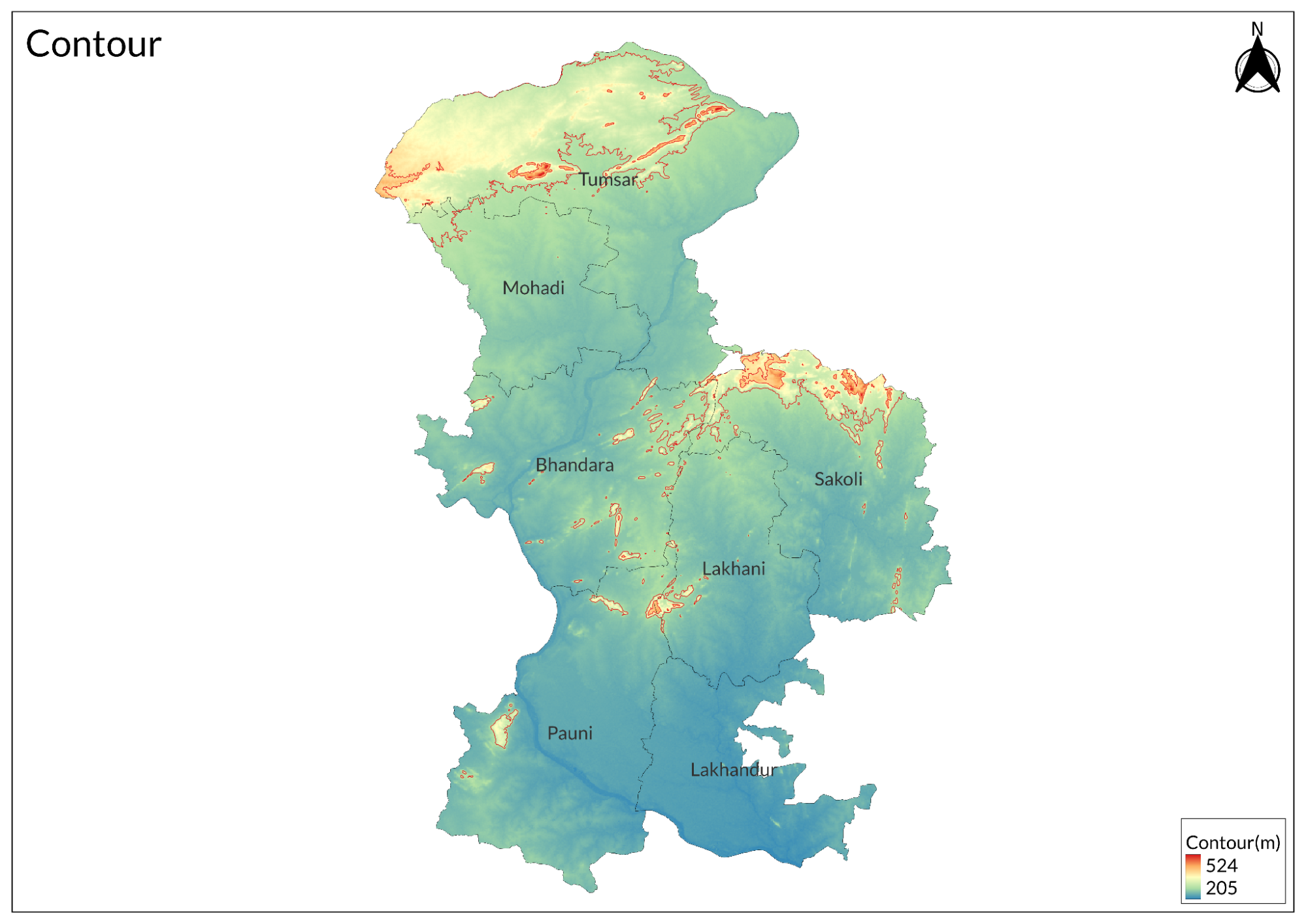
The Sakoli and Sausar series consist of rocks from the Archean (4 to 2.5 billion years ago) to the Proterozoic eras (2.5 to 544 million years ago), revealing the extensive and varied geological heritage of the Bhandara district. The southern half of Bhandara is covered by members of the Sakoli formations, while the Sausar series is found to the north. The area separating the Sausar and Sakoli belts is largely covered with alluvium, in which small exposures of the Sausar rocks occur.
Soil
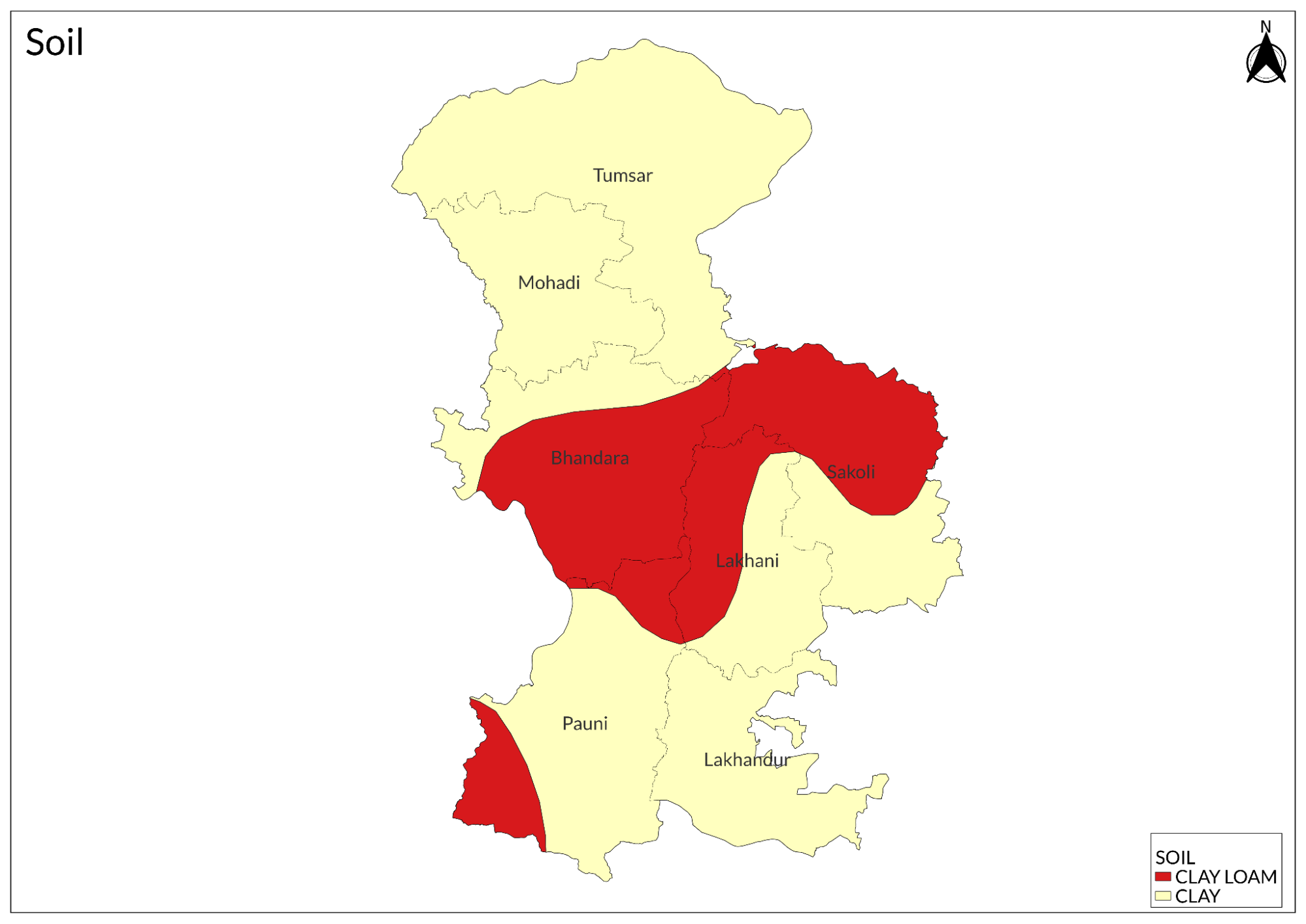
The soil in this region exhibits a diverse range shaped by the tropical sub-humid climate and the weathering of crystalline metamorphic and igneous rocks. Alluvial soils dominate along the southern stretches of the Wainganga Valley, downstream from Pauni, characterized by deep clay loams that are ideal for double cropping.
Kanhar soils are widely spread across the plains south of Bhandara, while morand soils, which are coarser in texture and found in higher ground away from rivers, are mixed with sand or lime, making them suitable for crops like wheat and linseed during the Rabi season. Khardi soils are shallow and gravelly, with a dark color and lime content, but are less fertile. Sihar soils, derived from crystalline rocks, are reddish-yellow and resilient to cracking in hot weather, often degrading into khardi variants.
Along riverbanks, immature soils such as black kachhar, marhani, and retari are found, offering varied conditions for cultivation. This diversity supports a vibrant agricultural landscape in Bhandara, where different soil types cater to various crops, enhancing the district's agricultural productivity and rural economy.
Minerals
Bhandara is rich in mineral resources, making it an excellent location for mining and economic growth. Manganese ore is prominently found in Dongri-Buzurg, Sitasaongi, and Chikla. Chromite deposits are located near Pauni, while kyanite-sillimanite deposits can be found in Pohra and Dahegaon.
Additionally, other minerals such as corundum are present near Pohra, gold is located near Koka village, and traces of uranium oxide have been identified near Parsori. High-quality hematite iron ore deposits are found near Maselli, Gogibherh, and Pahugaon.
The district also contains smaller but significant minerals like green mica, talc, soapstone, antimony, and lead, all of which contribute to its wealth of natural resources and potential for industrial development.
Rivers
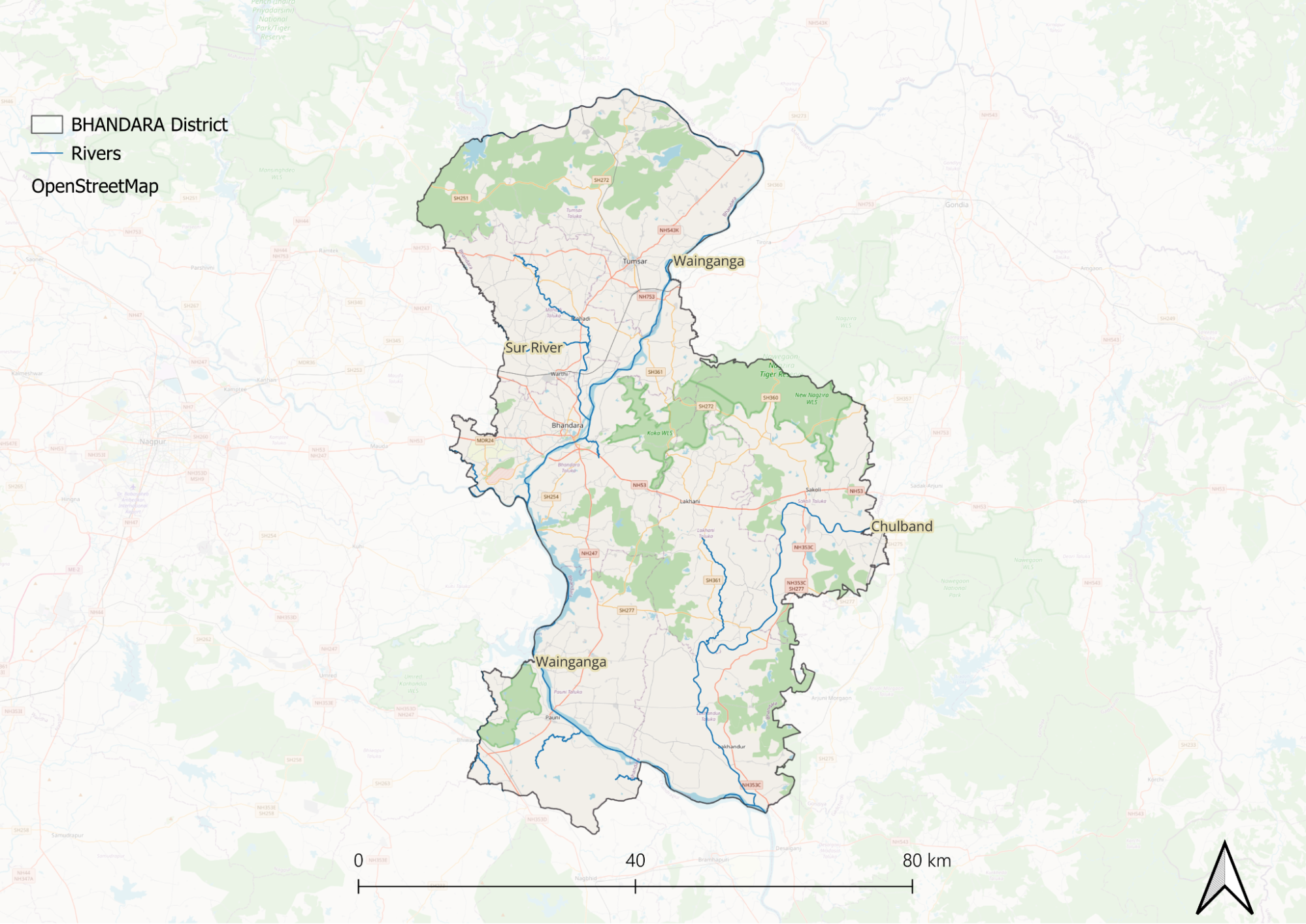
The Wainganga River flows diagonally across Bhandara town in the southwest, with its valley nestled between the Ambagarh and Gaikhuri ranges. It forms the boundary between Bhandara and Nagpur, further isolating the fertile strip of Pauni town from the rest of the district.
The Bagh River rises in Chichgarh village and flows for 113 km, occasionally forming the boundary between Bhandara and Balaghat. It joins the Wainganga near Beni, while another tributary on the left bank is the Chulband, which rises in the Gaikhuri range and flows south before joining the Wainganga.
The Pangoli River originates near Tumsar tahsil and joins the Bagh near Kamtha, while on the right bank, the Chandan River flows past Wara-Seoni and Rampaili before joining the Wainganga near Sawari village. While the Bawanthadi River flows down from Seoni district and joins Sur, coming from the east of Nagpur at Mowar village in Bhandara district.
Botany
Bhandara district encompasses an extensive forest area that covers almost 46% of its land. One-third of this area consists of reserved forests, half is designated as protected forests, and one-fifth is classified as unclassified forests. The forests primarily belong to the southern tropical dry deciduous category and are home to valuable species such as teak, which is notably found in the Tirora, Pratapgad, Rajoli, Tumsar, and Pauni ranges. Additionally, there are mixed forests rich in garari, sag, dhaora, lendia, aonla, tendu, mahua, achar, moyen, rohan, bija, bhandardara, salai, mokha, dhaman, semal, haldu, tiwas, chichwa, and sewan.
These forests serve as critical habitats for various wildlife species and are important for the production of bamboo, tendu leaves, and lac. Grazing areas are regulated to support local agriculture and livestock. Forest produce is transported to markets in Nagpur, Bhandara, Gondia, and beyond, contributing significantly to the regional economies and industries.
Wild Animals
Other notable species in the forest reserves include tigers, two types of panthers—pard and panther—jungle cats, hyenas, wild dogs, sloth bears (aswal), and wild pigs (ran dukkar). The district also supports a variety of deer species, such as sambhar, chital, barking deer (baiker), and occasionally the rare mouse deer. Efforts are ongoing to conserve these species, including the establishment of the Nagzira Wildlife Sanctuary.
The district hosts a significant variety of snakes, often depicted in local mandirs and texts, underscoring their historical significance. Both non-poisonous and poisonous species are commonly found in the district. Non-poisonous snakes include andha saap/kadu, kawdya saap, gargar, manjer saap, gavtya, diwad/dhondya, naneti/sitakilat, saraptoli/dongar yellya, nagin, dhaman, chitti/ajgar, and durkya ghonas/mandhol. Poisonous snakes include shendrya/raat, nag/chokha, dandekar, satranjya, ghunus, dhul-nagin, and tan sap/haranag.
Birds
The birds of the district include several brightly plumaged varieties such as golden orioles, blue rollers, kingfishers, woodpeckers, and little green flycatchers. Other commonly found birds include peacocks, jungle fowl, spurfowl, painted and rock sandgrouse, grey partridges, green pigeons, jungle quails, and a variety of doves.
The district features numerous tanks and perennial pools of water that provide shelter for a variety of migratory ducks during the colder months, as well as teal, pelicans, cranes, and herons in their vicinity.
Fishes
The district is endowed with extensive water resources, primarily sourced from the Wainganga River and its tributaries, covering approximately 500 km. These waters support a network of reservoirs, tanks, and ponds that are crucial for irrigation and fisheries. Managed by government authorities, these resources facilitate diverse activities, including fish farming. Plans include developing six large irrigation reservoirs and 50 smaller tanks, creating further opportunities for fisheries.
Local fisheries thrive on species such as tambir, wadis, kolshi, shivda, wagur, bodth, and tamboo, along with prawns like Macrobrachium malcolmsonii. The annual yield of riverine fish is around 100 metric tons, with prawn catches totaling about 10 metric tons. Traditional fishing methods include dugout canoes and clinker boats, as well as nets such as cast nets, drag nets (“zorli”), and gill nets (“atki jaal”), reflecting the district's robust fishing practices and rich aquatic biodiversity.
Forest Reserves
Koka- Nagzira Wildlife Sanctuary

The sanctuary is known for its abundant population of tigers, leopards, gaurs, cheetals, sambhars, wild dogs, ran-dukkar, and monkeys. Koka offers jungle safaris from morning to evening, covering a 44 km route over 3-4 hours. Visitors should plan their trips between November and June.
Umred Karhandla Wildlife Sanctuary
Umred Karhandla Wildlife Sanctuary is almost equidistant, located about 60 km from both Nagpur and Bhandara. It spans the Pauni tahsil of Bhandara district and the Umred, Kuhi, and Bhivapur talukas of Nagpur district. The sanctuary is situated 40 km north of Tadoba-Andhari Tiger Reserve, 50 km southwest of Nagzira Wildlife Sanctuary, and 60 km from Nagpur, Maharashtra. Additionally, Pench Tiger Reserve is located 80 km to the northwest.
The sanctuary is home to resident breeding tigers, herds of gaur, wild dogs, and rare animals such as flying squirrels, pangolins, and honey badgers. It is the only place in India where one can see five tigers in one frame. The sanctuary also hosts 90 species of birds, including 10 migratory bird varieties, 7 endangered avifauna species, and 19 different varieties of reptiles.
Land Use
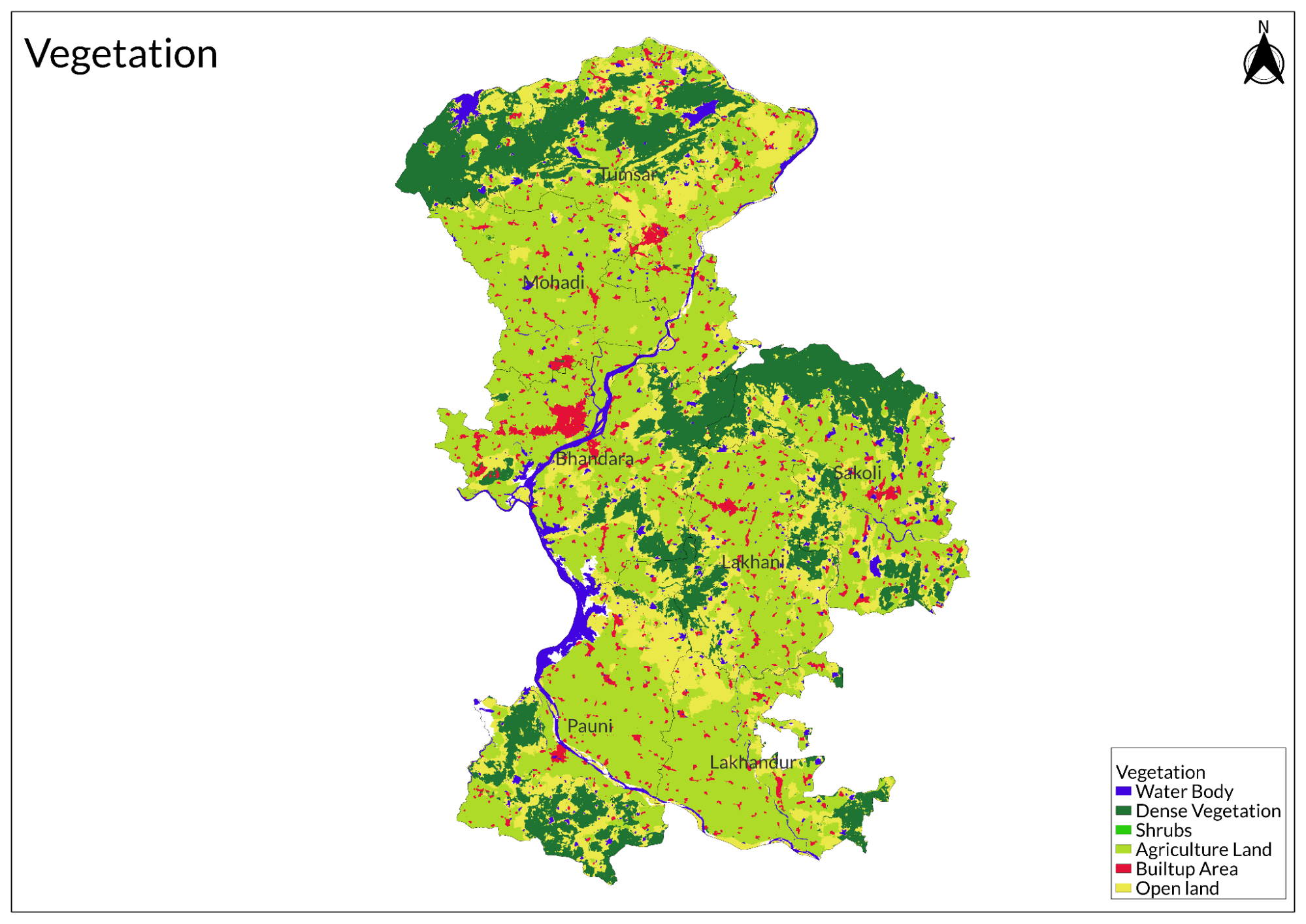
Environmental Concerns
Water Pollution
Water pollution in Bhandara district, Maharashtra, has become a significant environmental concern due to various human activities that compromise the quality of freshwater resources. The district faces substantial challenges from industrial growth, urbanization, and agricultural runoff, all of which contribute to the contamination of both surface and groundwater. The region is characterized by a reliance on groundwater for drinking, domestic use, and irrigation, making the integrity of this resource crucial for local communities.
The primary sources of water pollution in Bhandara include the discharge of untreated industrial effluents and municipal sewage into local water bodies. Industries such as brass manufacturing in Bhandara town release hazardous waste that contains high levels of copper (418.3 mg/l) and zinc (39.18 mg/l), significantly exceeding permissible limits set by health authorities. Additionally, the Sunflag Iron & Steel Industry contributes iron levels (55.85 mg/l) that also surpass acceptable thresholds.
Hydrochemical analyses from various groundwater samples indicate alarming levels of contamination. Approximately 16% of rural wells in the district have nitrate concentrations exceeding the World Health Organization's guideline of 50 mg/l, indicating anthropogenic contamination primarily from agricultural fertilizers and wastewater infiltration. Furthermore, about 8% of drinking water wells exceed the WHO standard for total dissolved solids (TDS), with concentrations averaging 816.75 mg/l, which is concerning for salinity issues.
Air Pollution
Illegal Mining
Illegal mining in Bhandara district, Maharashtra, has emerged as a significant environmental concern, prompting action from the National Green Tribunal (NGT). In 2021, the NGT addressed a case regarding illegal mining and stone crushing activities in Bhandara and neighboring Gondia districts, which was filed by Siddharth Developers & Suppliers against the state of Maharashtra. The tribunal criticized the Central Pollution Control Board (CPCB) for permitting mining operations that violated established environmental regulations.
The NGT's ruling highlighted the detrimental effects of illegal mining on the environment, including soil erosion, deforestation, and water pollution. These activities not only degrade the landscape but also threaten local ecosystems and biodiversity. The NGT ordered immediate action to curb these illegal operations, emphasizing the need for stricter enforcement of environmental laws.
In the Bhandara district, illegal sand mining has been particularly rampant. Reports indicate that the district administration suffered losses of approximately ₹12 crore due to unauthorized sand extraction from river ghats over six months. Despite the lack of official auctions for sand extraction—due to environmental impact assessments—illegal operations have continued unabated, leading to significant financial losses and environmental degradation.
Human-Wildlife Conflict
Recent reports indicate a notable increase in human-wildlife conflict incidents within the district. For example, there have been multiple cases of livestock predation by leopards and tigers, which not only causes economic losses for local farmers but also raises tensions between communities and wildlife. In just ten days, there were reports of a tiger attacking livestock three times, highlighting the urgency of addressing this issue.
Climate Change Vulnerability
Bhandara district in Maharashtra is increasingly vulnerable to climate change due to several interrelated factors. The weakening monsoon season, which traditionally spans from June to September, has become less predictable, impacting agricultural practices and water availability. This decline in monsoon strength is coupled with an increase in heavy rainfall events, leading to flooding and soil erosion. Additionally, rainfall distribution across the district is uneven, with some areas experiencing significantly more precipitation than others, further complicating water management efforts.
The district's vulnerability is exacerbated by the high percentage of small and marginal farmers, who constitute a significant portion of the agricultural community. These farmers often lack the resources and infrastructure needed to adapt to changing climatic conditions. The absence of adequate drainage and irrigation facilities makes it challenging for them to cultivate crops effectively, especially during extreme weather events. Furthermore, there is a notable deficiency in the dissemination of weather forecasts, which hinders farmers' ability to make informed decisions regarding planting and harvesting.
According to a study conducted by researchers from the Indian Council of Agricultural Research (ICAR), Bhandara is classified as one of the districts moderately vulnerable to climate change impacts, with significant risks posed to its agricultural sector. The study highlights that 77% of Maharashtra's cropped area is susceptible to climate-related challenges, including droughts and floods. In Bhandara, key crops such as jowar, rice, wheat, and sugarcane are likely to be adversely affected by these changing climate patterns.
Conservation Efforts
Malgujari Tanks
In Bhandara district, Maharashtra, a remarkable conservation initiative has emerged, focusing on the revival of traditional practices to protect and rejuvenate the region's ancient lakes. Known as the "Lake District of India," Bhandara was historically home to approximately 15,000 traditional tanks, or MaMa Talao, which played a crucial role in irrigation and fishing for local communities. However, these water bodies have faced significant threats over the years, including the proliferation of invasive fish species and habitat destruction.
The conservation efforts in Bhandara have been spearheaded by a trio of dedicated individuals: Manish Rajankar, a former bird enthusiast turned development worker; an elder from the Dheevar community (the local fisherfolk); and a courageous young woman from the same community. Together, they have harnessed traditional wisdom and encouraged local participation to safeguard their livelihoods while restoring over sixty lakes and water bodies in Bhandara and neighboring Gondia districts.
Manish Rajankar's journey into conservation began during his college years when he developed a passion for birdwatching and environmental protection. After being inspired by his professors, he decided to immerse himself in the community to understand their challenges better. In the early 2000s, he moved to Arjuni Morgaon in Gondia district, where he spent considerable time learning from Patiram Tumsare, a member of the Dheevar community. This hands-on experience provided him with invaluable insights into fishing practices, community dynamics, and the importance of sustainable management of local water bodies.
Rajankar's focus shifted towards empowering local leadership among water-dependent communities to ensure they could achieve sustainable livelihoods while conserving their traditional tank systems. A significant aspect of this initiative has been promoting gender parity in decision-making processes. Women from the Dheevar community have taken active roles in tank management, participating in village councils (Gram Sabhas) to advocate for their rights and influence decisions that affect their lives.
In 1996, Rajankar joined the Bhandara Nisarga Va Sanskruti Abhyas Mandal (BNVSAM), a non-profit organization founded by environmental enthusiasts in 1993. This organization has played a vital role in facilitating community-led conservation initiatives. Rajankar later became the Principal Investigator for a project on Freshwater Biodiversity Conservation under the Maharashtra Gene Bank Programme, further emphasizing his commitment to preserving local ecosystems.
The results of these efforts have been profound. The rejuvenation of lakes has not only restored essential habitats for local flora and fauna but has also provided new hope for the livelihoods of local communities. The involvement of women in decision-making processes has empowered them economically and socially, fostering a sense of ownership over their natural resources.
In Bhandara, the Forest Department and government schools, such as Zilla Parishad Schools, are actively engaged in environmental protection efforts. In addition to these institutions, several non-governmental organizations (NGOs) contribute to environmental conservation in the district:
- Bhandara Nisarga Va Sanskruti Abhyas Mandal (BNVSAM): Founded in 1993 by environmental enthusiasts, this NGO focuses on preserving Bhandara's environmental heritage and raising awareness among local communities. Manish Rajankar, an environmentalist who joined the organization later, has been instrumental in efforts to preserve the district's lakes.
- Help and Helpline Foundation: Located in Takiya ward of Bhandara District, this NGO works to provide clean drinking water at the village level and is involved in conserving other natural resources.
- Udayan Bahuddehsiya Vikas Sanstha: Situated near Gurjar Chowk on Kham Lake Road, this NGO engages in various social welfare activities, including natural resource conservation and tree plantation initiatives.
- Vidarbha Nature Conservation Society: This organization operates across all districts of Vidarbha, including Bhandara, focusing on water preservation, tree plantation, deforestation prevention, and the protection of other natural resources.
- Vanvasi Kalyan Ashram of Rashtriya Swayamsevak Sangh: Dedicated to the welfare of forest dwellers, particularly tribal communities, this organization educates these populations about nature conservation and sustainable resource management.
Graphs
Water
Climate & Atmosphere
Forests & Ecology
Human Footprint
Sources
Devendra Pandey & S.S. Rathore. 2011. Water Quality Assessment of Bhandara and Gondia Districts of Maharashtra State. ResearchGate.https://www.researchgate.net/publication/216…
Lokmat. Increase in Incidence of Wildlife-Human Conflict in Bhandara. Lokmat, Bhandara.https://www.lokmat.com/bhandara/increase-inc…
Maharashtra Pollution Control Board (MPCB). 2022. Executive Summary - Environmental Impact Assessment, Bhandara. MPCB.https://www.mpcb.gov.in/sites/default/files/…
Mongabay India. 2020. Returning to Traditional Practices to Save Vidarbha's Lake District. Mongabay India, December.https://india.mongabay.com/2020/12/returning…
The Times of India. 2012. Illegal Sand Mining: ₹17L Recovered for ₹12 Cr Loss. Times of India, December 10.https://timesofindia.indiatimes.com/city/nag…
Times of India. 2021. Maharashtra: Study Says 11 Districts Highly Vulnerable to Extreme Weather Events, Droughts. Times of India, August 6.https://timesofindia.indiatimes.com/city/mum…
Last updated on 6 November 2025. Help us improve the information on this page by clicking on suggest edits or writing to us.